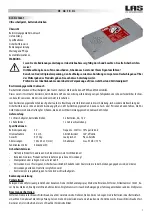
PDi Communication Systems, Inc. 40 Greenwood Lane Springboro, Ohio 45066 USA PH 1-800-628-9870 FX 937-743-5664
Document Number: PD196-293R1
PD251-031 Android Based Module
Page 31 of 35
Q.
Can they save data to the device?
A. Yes, any data downloaded by the apps like files; pictures, etc. are saved in the user space. All this is protected by a user
chosen password and gets wiped out when a new user comes in (and touches the “I’m a new user” button)
Q
. Is the device encrypted?
A. Android comes with encryption function – where you can encrypt the full device (will take an hour to encrypt – normally
would be on a per user basis) with a numeric PIN/password and decrypt it each time you power it on. Currently, we have
disabled it on the Android based module – The “Encrypt device” is disabled under the settings->Security. The module would
normally be physically secured and cannot be easily stolen/displaced – so unlike phones or tablets, it would be difficult to
open the device and retrieve the data from inside it without anyone knowing about it. Also Full device encryption may be too
cumbersome for changing users/patients. So we would have to have encrypted data on a per app basis. For example, the
apps that deal with patient information should be storing encrypted data on the device for additional confidentiality.
Q.
Can Mobile Device Management applications like MobileIron be loaded on the device?
A. The Android based module conforms to standard Android Interface - Version 4.3 Jelly Bean, API Level 18, so any
app written to that interface and not requiring any hardware feature not supported by the PDi-Tab could be loaded on
the Pdi-Tab.
A quick way to check this or any app would be to install the app on the device (in the user space) and check whether it
works as intended. In a future OTA update, the PDi-Store and its WSO2 Agent app will allow for mobile device
management capabilities as an alternative to applications like MobileIron.
Q.
Do Master IP addresses need to be constant or are there other ways to handle dynamic IP addresses?
A.
We have the provision to have fixed IP address on the Android based module, but we could solve the problem of
dynamic IP addresses in other ways:
1. By using the master network name in the cloning configuration – the Android module has a unique network name by
default – e.g. P14T-051b49D4D72D7422. Other Android based modules can access the master device by name
instead of an IP address. An IT administrator should be able to address this.
2. It is also possible to keep the clone file onan HTTP server e.g. www<yourwebsitehere>/P14Tab/clone.ab and use
that configuration for slaves.
Q.
How much band width do typical applications use?
A. Bandwidth Usage – This is just an indicative list. Please note that typical cases may vary.
A typical number of user supported scenario is given below. Note that the actual numbers would depend on many other
factors including but not limited to actual network bandwidth, network configuration, other users on the network, other
background applications taking up bandwidth, media/video content, etc.
Activity
Bandwidth Usage per Activity
One hour of text-based instant messaging (IM) chatting
~0.01 MB
Sending one email via Webmail, Gmail, etc.
~0.2 MB if email is plain text with no attachments
Uploading a photo to Flickr
Less than 1 MB, if the photo is resized to 1024 x 768
Downloading a three-minute song from iTunes, Amazon,
t
2-5 MB, depending on the song and encoding
lit
Watching a five-minute video clip from YouTube
~5 MB (1 MB per minute, on average)
Using video chat on Skype for 15 minutes
2.7-14.4 MB
Watching a two-hour streaming movie from Netflix,
iTunes, Amazon, Hulu, etc.
~2 GB at 640 x 480 resolution
Listening to Pandora for one hour
56.25 MB, assuming 128 Kbps streaming rate





































